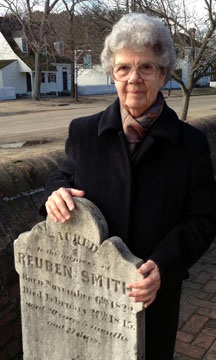Swem archives reveal answer to 170-year-old mystery
When Naomi Marrow talks about Reuben Smith, it’s easy to assume he was a close member of her family. Her eyes light up when she talks about his love of hot cornbread and how he enjoyed dancing and playing chess. She laughs about how he teased his best friend, George, by smoking his cigars under the guise of preserving George’s health. She relays with sadness how his life was cut short by illness.
But Reuben Smith – this charming, witty young man who aspired to be a doctor – never knew Naomi Marrow. That’s because Smith lived and died 170 years ago, but the letters he left behind would one day bridge the gap between two people separated by the centuries.
 “I walk by Bruton Parish
almost every day. One day I saw Reuben’s headstone and it made me sad
that I didn’t know his story,” Marrow said. “I’m not a historian, so I
really didn’t know how to go about learning about him, but I was
determined to figure it out.”
“I walk by Bruton Parish
almost every day. One day I saw Reuben’s headstone and it made me sad
that I didn’t know his story,” Marrow said. “I’m not a historian, so I
really didn’t know how to go about learning about him, but I was
determined to figure it out.”
Marrow began searching for information. She soon discovered that Smith lived in the Tucker House with his sister, Lucy Ann Smith, and her husband, Nathaniel Beverley Tucker, and that he graduated from the College of William & Mary in 1842.
“It was like finding pieces of a puzzle. One piece of information led to another and another, and it went from there,” she said.
Marrow even located one of Smith’s descendants, gathering more details on the short life of this young man. But one piece of the puzzle continued to elude her.
“I had learned a lot about Reuben, but I still hadn’t discovered how he died. I had so much information, but this one piece of his life was missing,” she said.
So she wrote an essay entitled, “Who Was Reuben Smith?” that was printed in the Virginia Gazette. From that essay, came this advice: “Go to Swem Library.”
“When I arrived at Swem, they brought out a box of Tucker family letters. When I first held a letter in my hands that Reuben had written himself, it was an amazing feeling,” she said.
In that box, Marrow found the answer she had been seeking. In a letter of condolence from George to Lucy Ann, George explained that while tending the poor in Philadelphia, Smith contracted tuberculosis. He returned to Williamsburg in 1842 and died in an upstairs room of the Tucker House in February 1843.
“He died helping the sick. I think that’s a very noble way to die,” Marrow said.
In January Marrow entered her story in Swem’s archives contest, in which library users shared what they’ve found in the library’s special collections and what impact their discovery had on them personally.
“I entered the contest because I want people to know about Reuben. I don’t want his headstone to just be a headstone,” she said. “By telling his story, I’m keeping him alive because I’m helping people remember him.”
Marrow’s entry won over the voters, making her the contest winner, and now she advances to the national competition.
“Naomi’s entry is the perfect example of how archives are a living and breathing experience for our visitors,” said Amy Schindler, acting Marian & Alan McLeod Director of Swem’s Special Collections Research Center. “Archives have the power to create a connection with the past and bring people and events alive today.”
Marrow visited Swem with her daughters, Colleen and Karen, this month to receive her contest prizes – a behind-the-scenes tour of the library’s Special Collections Research Center and a $100 Barnes & Nobles gift card. Little did she know what a treat the library staff had in store for her.
Staff had uncovered several textbooks in special collections that had belonged to Reuben – some of which he had even doodled in. When she entered the room where the books had been placed on display and realized what she was seeing, she began to cry.
“Oh, this is just amazing,” Marrow said as she carefully turned the pages in a math book that Reuben had drawn designs in. “To know that he drew these things, that he touched this book, it amazes me.”
Swem archivists plan to make some of Smith’s books available online, so that Marrow and others interested in what a William & Mary student in the early 19th century was studying – and doodling – can access them.
Marrow wonders what Reuben would have thought knowing someone cared about him – enough to discover the details of his short life – nearly 200 years later. Would he be happy that she brought his life story to light? We, at Swem Library, certainly believe so.
 Skip to main content
Skip to main content
